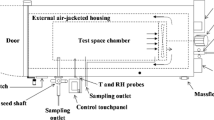Abstract
Basing on the material emission data obtained in a test chamber, chemical mass balance (CMB) was used to assess the source apportionment of volatile organic compound (VOC) concentrations in three newly built timber frame houses. CMB has been proven to be able to discriminate the source contributions for two contrasted environmental conditions (with and without ventilation). The shutdown of the ventilation system caused an increase in the VOC concentrations due to the increased contribution of indoor surface materials like the door material and furniture explaining together over 65% of total VOCs. While the increase in formaldehyde concentration is mainly due to furniture (contribution of 70%), the increase in α-pinene concentration is almost exclusively attributable to the emission of door material (up to 84%). The apportionment of VOC source contributions appears as highly dependent on the position of source materials in the building (surface materials or internal materials) and the ventilation conditions explaining that the concentrations of compounds after the shutdown of ventilation system do not increase in equivalent proportion. Knowledge of indoor sources and its contributions in real conditions may help in the selection of materials and in the improvement of construction operations to reduce the indoor air pollution.




Similar content being viewed by others
References
ASTM E 741–11 (2011) Standard test method for determining air change in a single zone by means of tracer gas dilution. ASTM International, West Conshohocken
Badol C, Locoge N, Galloo JC (2008) Using a source-receptor approach to characterize VOC behaviour in a French urban area influenced by industrial emissions part II: source contribution assessment using the chemical mass balance (CMB) model. Sci Total Environ 389:429–440
Baumann MGD, Lorenz LF, Batterman SA, Zhang GZ (2000) Aldehyde emissions from particleboard and medium density fiberboard products. For Prod J 50:75–82
Bourdin D, Desauziers V (2014) Development of SPME on-fiber derivatization for the sampling of formaldehyde and other carbonyl compounds in indoor air. Anal Bioanal Chem 406:317–328
Britt HI, Luecke RH (1973) The estimation of parameters in nonlinear implicit models. Technometrics 15:233–247
Cattaneo A, Fermo P, Urso P, Grazia-Perrone M, Piazzalunga A, Tarlassi J, Carrer P, Cavallo DM (2016) Particulate-bound polycyclic aromatic hydrocarbon sources and determinants in residential homes. Environ Pollut 218:16–25
Dacunto PJ, Cheng KC, Acevedo-Bolton V, Jiang RT, Klepeis NE, Repace JL, Ott WR, Hildemann LM (2014) Identifying and quantifying secondhand smoke in source and receptor rooms: logistic regression and chemical mass balance approaches. Indoor Air 24:59–70
Derbez M, Berthineau B, Cochet V, Lethrosne M, Pignon C, Riberon J, Kirchner S (2014) Indoor air quality and comfort in seven newly built energy-efficient houses in France. Build Environ 72:173–187
Desauziers V, Bourdin D, Mocho P, Plaisance H (2015) Innovative tools and modeling methodology for impact prediction and assessment of the contribution of materials on indoor air quality. Heritage Sci 3:28
Fujita EM, Watson JG, Chow JC, Lu Z (1994) Validation of the chemical mass balance receptor model applied to hydrocarbon source apportionment in the southern California air quality study. Environ Sci Technol 28:1633–1649
Fujita EM, Watson JG, Chow JC, Magliano KL (1995) Receptor model and emissions inventory source apportionments of non-methane organic gases in California’s San Joaquin Valley and San Fransisco bay area. Atmos Environ 29:3019–3035
Gokhale S, Kohajda T, Schlink U (2008) Source apportionment of human personal exposure to volatile organic compounds in homes, offices and outdoors by chemical mass balance and genetic algorithm receptor models. Sci Total Environ 407:122–138
Harley R, Hannigan MP, Cass GR (1992) Respeciation of organic gas emissions and detection of excess unburned gasoline in the atmosphere. Environ Sci Technol 26:2395–2408
Hasheminassab S, Daher N, Shafer MM, Schauer JJ, Delfino RJ, Sioutas C (2014) Chemical characterization and source apportionment of indoor and outdoor fine particulate matter (PM2.5) in retirement communities of the Los Angeles Basin. Sci Total Environ 490:528–537
Hellén H, Hakola H, Laurila T (2003) Determination of source contributions of NMHCs in Helsinki (60 °N, 25 °E) using chemical mass balance and unmix multivariate receptor models. Atmos Environ 37:1413–1424
Hodgson AT, Rudd AF, Beal D, Chandra S (2000) Volatile organic compound concentrations and emission rates in new manufactured and site-built houses. Indoor Air 10:178–192
Hopke PK (1991) Receptor modeling for air quality management. Elsevier Science Publishers, Amsterdam, The Netherlands, Vol 7
Hyttinen M, Masalin-Weijo M, Kalliokoski P, Pasanen P (2010) Comparison of VOC emissions between air-dried and heat-treated Norway spruce (Picea abies), scots pine (Pinus sylvesteris) and European aspen (Populus tremula) wood. Atmos Environ 44:5028–5033
Junninen H, Monster J, Rey M, Cancelinha J, Douglas K, Duane M, Forcina V, Muller A, Lagler F, Marelli L, Borowiak A, Niedzialek J, Paradiz B, Mira-Salama D, Jimenez J, Hansen U, Astorga C, Stanczyk K, Viana M, Querol X, Duvall RM, Norris GA, Tsakovski S, Wahlin P, Horak J, Larsen BR (2009) Quantifying the impact of residential heating on the urban air quality in a typical European coal combustion region. Environ Sci Technol 43:7964–7970
Kopperud RJ, Ferro AR, Hildemann LM (2004) Outdoor versus indoor contributions to indoor particulate matter (PM) determined by mass balance methods. J Air Waste Manage Assoc 54:1188–1196
Liang W, Wang C, Yang C, Yang X (2014) Volatile organic compounds in different interior construction stages of an apartment. Build Environ 81:380–387
Manninen AM, Pasanen P, Holopainen JK (2002) Comparing the VOC emissions between air-dried and heat-treated scots pine wood. Atmos Environ 36:1763–1768
McLaren R, Singleton DL, Lai JYK, Khouw B, Singer E, Wu Z, Niki H (1996) Analysis of motor sources and their contribution to ambient hydrocarbon distributions at urban sites in Toronto during the southern Ontario oxidants study. Atmos Environ 30:2219–2232
Mukund R, Kelly TJ, Spicer CW (1996) Source attribution of ambient air toxic and other VOCS in Columbus, Ohio. Atmos Environ 30:3457–3470
Mugica V, Vega E, Chow J, Reyes E, Sanchez G, Arriaga J, Egami R, Watson J (2001) Speciated non-methane organic compounds emissions from food cooking in Mexico. Atmos Environ 35:1729–1734
Olson DA, Turlington J, Duvall RV, Vicdow SR, Stevens CD, Williams R (2008) Indoor and outdoor concentrations of organic and inorganic molecular markers: source apportionment of PM2.5 using low-volume samples. Atmos Environ 42:1742–1751
Plaisance H, Leonardis T, Gerboles M (2008) Assessment of uncertainty of benzene measurements by Radiello diffusive sampler. Atmos Environ 42:2555–2568
Plaisance H, Blondel A, Desauziers V, Mocho P (2014) Hierarchical cluster analysis of carbonyl compounds emission profiles from building and furniture materials. Build Environ 75:40–45
Plaisance H, Vignau-Laulhere J, Mocho P, Sauvat N, Raulin K, Desauziers V (2017) Volatile organic compounds concentrations during the construction process in newly-built timber frame houses: source identification and emission kinetics. Environ Sci: Processes Impacts 19:696–710
RT2012 (2011) Un saut énergétique pour les bâtiments neuf. Ministère de l’Ecologie, du Développement durable, des Transports et du Logement, Paris, France, www.developpement-durable.gouv.fr
Tham KW (2016) Indoor air quality and its effects on humans—a review of challenges and developments in the last 30 years. Energy Buildings 130:637–650
Vega E, Mugica V, Carmaona R, Valencia E (2000) Hydrocarbon source apportionment in Mexico City using the chemical mass balance receptor model. Atmos Environ 34:4121–4129
Vignau-Laulhere J, Plaisance H, Mocho P, Raulin K, Bigay Y, Desauziers V (2015) Performance of the Radiello diffusive sampler for formaldehyde measurement: the influence of exposure conditions and ozone interference. Anal Methods 7:5497–5503
Vignau-Laulhere J, Mocho P, Plaisance H, Raulin K, Desauziers V (2016) Assessment of diffusion parameters of new passive samplers using optical chemical sensor for on-site measuring formaldehyde in indoor air: experimental and numerical studies. Anal Bioanal Chem 408:2147–2157
Watson JG, Cooper JA, Huntzicker JJ (1984) The effective variance weighting for least square calculations applied to the mass balance receptor model. Atmos Environ 18:1347–1355
Watson JG, Robinson NF, Chow JC, Fujita EM, Lowenthal DH (1998) CMB 8 User's manual, Report EPA-454/R-01, U.S. EPA, United States
Watson JG, Chow JC (1991) Chemical mass balance. In: Hopke PK, editor. Receptor modeling for air quality management 7ème edn: p. 83–112
Acknowledgements
The project partners thank ADEME for the financial support through the CORTEA program.
Author information
Authors and Affiliations
Corresponding author
Additional information
Responsible editor: Constantini Samara
Rights and permissions
About this article
Cite this article
Plaisance, H., Mocho, P., Sauvat, N. et al. Using the chemical mass balance model to estimate VOC source contributions in newly built timber frame houses: a case study. Environ Sci Pollut Res 24, 24156–24166 (2017). https://doi.org/10.1007/s11356-017-0025-z
Received:
Accepted:
Published:
Issue Date:
DOI: https://doi.org/10.1007/s11356-017-0025-z




